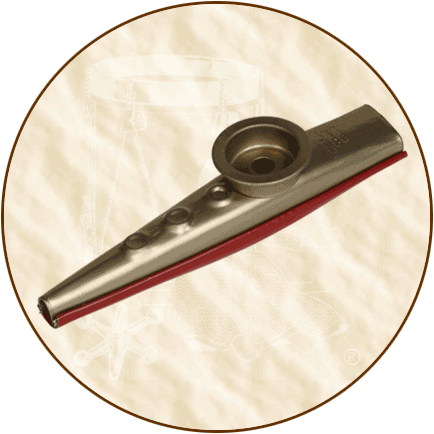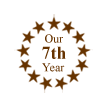.
Continued from product description on
Folk Instruments' Page One...
Historical
Background: The kazoo is a simple musical instrument (membranophone)
that produces tonal qualities when a player hums into it. The
kazoo is also a type of vibrating membrane instrument known as
"mirlitons." The kazoo dates back hundreds of years
to its oldest known relative, the horn-mirliton, an African version
of the mirliton. Horn-mirlitons' tubes were made from cow horns,
and the eggshells of spiders were used for the membranes. African
horn-mirlitons were often used at tribal gatherings to distort
or mask voices.
The first European mirlitons were created in the 17th century
and were called "eunuk flutes." During the 1800s, various
forms of kazoos could be found throughout North America. And
even though these instruments varied in construction, they were
all similar to the kazoo. These early American mirlitons were
based on the African version and primarily used for folk music.
By the mid-18th century, the kazoo began to become popular
and make its mark on music history. The first kazoo as we know
it today came as an idea in the 1840s to Alabama Vest of Macon,
Georgia, and was made with the help of a German clock manufacturer,
Thaddeus von Glegg. The kazoos they made were soon adopted by
musicians in Jazz, Jug, and Hillbilly bands.
A traveling salesman by the name of Emil Sorg chanced upon
Vests and von Glegg's kazoo. Sorg was so impressed with the market
potential for this instrument, he went to New York to produce
his own kazoos. Sorg eventually partnered with a Buffalo tool
and die maker by the name of Michael McIntyre. The first production
run of kazoos occurred in 1912.
A year later, McIntyre had obtained the knowledge necessary
to manage kazoo production by himself. What he lacked was a larger
factory. To solve this problem, McIntyre partnered with Harry
Richardson, the owner of a large metal factory in Eden, New York,
and they began mass producing kazoos in 1914. Soon, sales of
kazoos increased as their popularity grew. These two men renamed
their partnership in 1916 and called it The Original American
Kazoo Company.
As the popularity and sales of kazoos continued to grow in
the 1920s and 1930s, so did the competition. Others thought making
and selling kazoos was a smart idea. To stave off this competition,
McIntyre applied for and was granted a U.S. patent in 1923. The
Original American Kazoo Company continued to produce kazoos the
same way they did in 1916 until the factory closed in 2003. The
company also maintains a working museum housed in the original
factory that tells the history of kazoos, provides amusing trivia,
and demonstrates the manufacturing process.
Our metal kazoos (5001) are made according to the historical
specifications established by The Original American Kazoo Company
in 1916.
Fun
Fact: The Kazoo was exhibited at the 1852 Georgia State
Fair and was later manufactured under the name "Down South
Submarine" because of its shape.
Fun
Fact: Although the origin of the kazoo is African, it
has since become as American as apple pie and considered by some
to be the "most democratic musical instrument" since
anyone who can hum a tune can also play a kazoo!
Fun
Fact: König Ludwig von Bayern had a 2.13-meter-long
mirliton made for an opera by Wagner. This instrument was constructed
with extremely "fat" eunuks that were imported from
the Ottoman kingdom.
Fun
Fact: You can "make" a kazoo by wrapping a tissue
paper or piece of wax paper around a hair comb. Try it if you
have not already!













